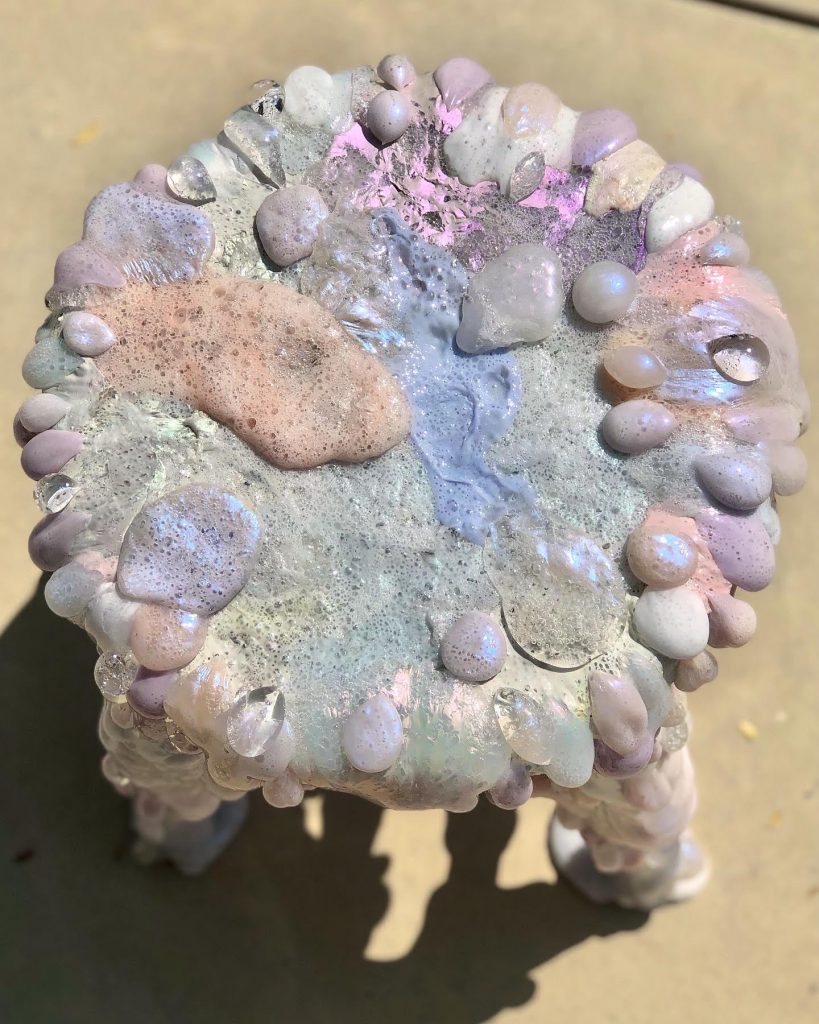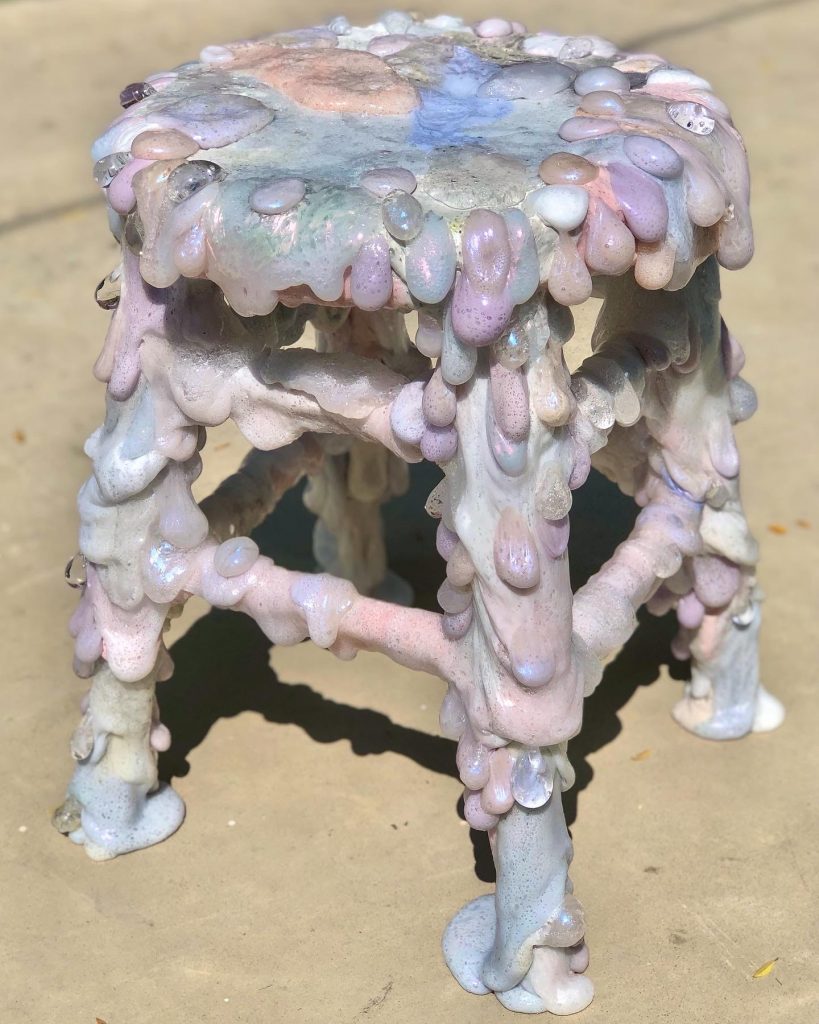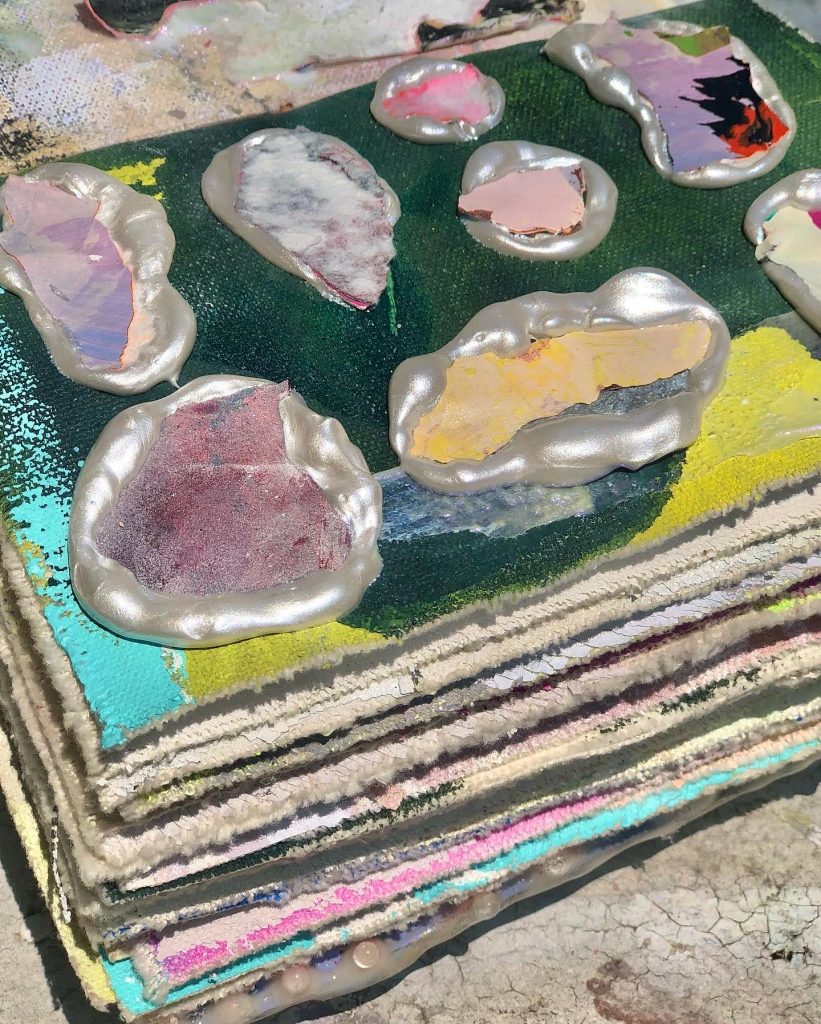Scavenge and Destroy with Laura Soto

Curiosity, wonder, disruption and discovery all find refuge in Laura Soto’s sculptures. Ever returning to her childhood beach-combing experiences for inspiration, Soto’s trial-and-error practice relies on found fragments from her studio, her friends, the art store, even traditional materials like resins, glues and pigments. This “ever-evolving loop of experimentation” is coupled with Soto’s uncompromising fascination with both catalogue and chaos, with preservation and material destruction. Her sculptures call upon the craggy West coast, the luminescence of seashore treasures, and broken, alien bits that highlight Soto’s talent for material scavenging. The finished products, often made in ethereal pastel hues, are drippy, pearlescent, beautiful oddities.
Studying Studio Art at Biola University, Soto initially practiced as a painter before turning her creative prowess to sculpture. Since, she has shown at Leiminspace in Chinatown, Los Angeles, Galleria Salvatore Lanteri in Milan, and exhibited her solo exhibition, Flesh and Flood, with MaRS in 2018. She has contributed to Through a Glass Darkly at Friends Artspace in Arlington, Virginia, MaRS Gallery’s Obscured and Objectified gallery shop, Corrupted Ceramics group show with Galleria Salvatore Lanteri, and MAS Attack at the Torrance Art Museum. Soto now resides in Los Angeles, where her studio is located.
FRONTRUNNER chatted with Laura about the coast, order and chaos in creation, and her basic studio essentials.

Tell me what initially drew you to the ocean, shells and the beach – and what compelled you to turn towards sculpture as a medium?
The coast was inherently part of my childhood/adolescent landscape – I grew up in San Diego and spent many road trips over those years exploring the California Central Coast. The posture of discovery and exploration and collecting I developed in those formative years would echo back to me once I began working in a cumulative, processed based manner. The weathered, grotesque, and yet still luminous, aesthetic of rocks and shell and bone fragments left me curious. I loved the gnarled and sculpted textures of the beaches – a threshold between earth and water – two discordant elements meeting and changing each other.
You said that shells are centrally inspirational, but you use resins, paper, and acrylic to create your works. How did you first find the materials to express the organic look you desired, and do you often switch up your creative process in order to find new materials to use?
I’d say shells are a core inspiration the same way rocks and bark and sea-life are. I don’t work conceptually with an end in mind or ever think “I want this piece to look like abalone”. I start with a color or size to feature or move towards – and then begin building and amassing layer upon layer of material until it feels like I need to erode. My smorgasbord of materials is ever evolving. This practice began in undergrad when, as I’d build up texture on large paper forms, I found myself mixing oil and acrylic to observe how they resisted and changed each other. From there, I began exploring other aisles of the art store, introducing glues and resins and pigment. When I’d explored all the local art and craft stores, I moved onto the hardware store. Then, collecting various ‘spoiled’ material that friends were throwing out. Trial and error became a sacred aspect of my process. I am perpetually looking for new elements to introduce.

I find your books so interesting – could you tell me more about how you came up with the idea to meld sculpture and book binding?
The books began as, and, largely still are, my personal sketchbooks. I’ve never limited myself to strictly dry material when “sketching” and various oozes would seep onto the covers. Overtime, I began doing it intentionally, embracing my desire for form over function.
What are three things in your studio that you can’t live without, and why?
First, would be my sketchbook. This is usually always splayed open to catch the odd drip of paint or to wipe my hands in. I like this decidedly un-precious approach to mark making – creating a haphazard first layer to build upon later. Second would be the strange array of wire cutters I often use to shape and carve my pieces. I’ve found most blades too perilous for my clumsy self. When digging into a piece that has layers of resins and concrete interspersed throughout the more forgiving acrylic, precise and delicate tools break or slip. Wire cutters and the odd gardening tool work great, are much more steady in my hand, if a little cumbersome. Third has to be my Bluetooth speaker. I am a voracious listener to Podcasts while I’m working – often ones concerning science or the natural world.
Tell me more about that tension you experience between destroying and preserving finished work.
This is a constant in my practice. When something feels ‘finished’ I will move it out of the workspace and into the display area. This creates a distance wherein I can observe it, but, I am not precious about it. Destruction may still strike – I follow the curiosity wherever it leads. Deconstructing a piece is, arguably, an act of creation as well – I save all the fragments. Nothing will be lost. It will be subsumed into some other form and bring with it a sense of history and time that would not exist otherwise.

As a sculptor, do you have any core messages that you want to consistently express in your works? How does your artistic perspective as a sculptor differ from your prior creative experience as a painter?
The work is the message – the long-winded process and play – the trial and error – the weathering and building. My perspective as a sculptor is less focused on the finished piece and infinitely, intimately, obsessed with the act of making/discovering throughout the process I set in motion.
If you could see into the future, what would you predict art and design will look like in the coming few years?
The past two years have been exhausting, isolating, and illuminating. I see art and design reflecting our hunger for the tactile – trying to bridge and reconcile and explore the distance between the digital and the dimensional. Spending so much of the work day interfacing with screens, I crave the spectrum of textures and smells and sounds my studio offers.









Responses